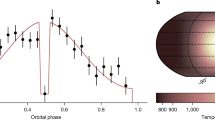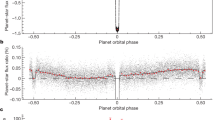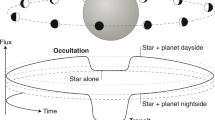Abstract
Of the over 200 known extrasolar planets, just 14 pass in front of and behind their parent stars as seen from Earth. This fortuitous geometry allows direct determination of many planetary properties1. Previous reports of planetary thermal emission2,3,4,5 give fluxes that are roughly consistent with predictions based on thermal equilibrium with the planets’ received radiation, assuming a Bond albedo of ∼0.3. Here we report direct detection of thermal emission from the smallest known transiting planet, HD 149026b, that indicates a brightness temperature (an expression of flux) of 2,300 ± 200 K at 8 µm. The planet’s predicted temperature for uniform, spherical, blackbody emission and zero albedo (unprecedented for planets) is 1,741 K. As models with non-zero albedo are cooler, this essentially eliminates uniform blackbody models, and may also require an albedo lower than any measured for a planet, very strong 8 µm emission, strong temporal variability, or a heat source other than stellar radiation. On the other hand, an instantaneous re-emission blackbody model, in which each patch of surface area instantly re-emits all received light, matches the data. This planet is known6,7,8,9 to be enriched in heavy elements, which may give rise to novel atmospheric properties yet to be investigated.
This is a preview of subscription content, access via your institution
Access options
Subscribe to this journal
Receive 51 print issues and online access
$199.00 per year
only $3.90 per issue
Buy this article
- Purchase on Springer Link
- Instant access to full article PDF
Prices may be subject to local taxes which are calculated during checkout




Similar content being viewed by others
References
Charbonneau, D., Brown, T. M., Burrows, A. & Laughlin, G. in Protostars and Planets V (eds Reipurth, B., Jewitt, D. & Keil, K.) 701–716 (Univ. Arizona Press, Tucson, Arizona, 2007)
Charbonneau, D. et al. Detection of thermal emission from an extrasolar planet. Astrophys. J. 626, 523–529 (2005)
Deming, D., Seager, S., Richardson, L. J. & Harrington, J. Infrared radiation from an extrasolar planet. Nature 434, 740–743 (2005)
Deming, D., Harrington, J., Seager, S. & Richardson, L. J. Strong infrared emission from the extrasolar planet HD 189733b. Astrophys. J. 644, 560–564 (2006)
Knutson, H. A. et al. A map of the day-night contrast of the extrasolar planet HD 189733b. Nature 447, 183–186 (2007).
Sato, B. et al. The N2K Consortium. II. A transiting hot Saturn around HD 149026 with a large dense core. Astrophys. J. 633, 465–473 (2005)
Fortney, J. J., Saumon, D., Marley, M. S., Lodders, K. & Freedman, R. S. Atmosphere, interior, and evolution of the metal-rich transiting planet HD 149026b. Astrophys. J. 642, 495–504 (2006)
Ikoma, M., Guillot, T., Genda, H., Tanigawa, T. & Ida, S. On the origin of HD 149026b. Astrophys. J. 650, 1150–1159 (2006)
Broeg, C. & Wuchterl, G. The formation of HD 149026b. Mon. Not. R. Astron. Soc. 376, L62–L66 (2007)
Fazio, G. G. et al. The Infrared Array Camera (IRAC) for the Spitzer Space Telescope. Astrophys. J. Suppl. 154, 10–17 (2004)
Werner, M. W. et al. The Spitzer Space Telescope Mission. Astrophys. J. Suppl. 154, 1–9 (2004)
Seager, S. et al. On the dayside thermal emission of hot Jupiters. Astrophys. J. 632, 1122–1131 (2005)
Harrington, J. et al. The phase-dependent infrared brightness of the extrasolar planet υ Andromedae b. Science 314, 623–626 (2006)
Cooper, C. S., Sudarsky, D., Milsom, J. A., Lunine, J. I. & Burrows, A. Modeling the formation of clouds in brown dwarf atmospheres. Astrophys. J. 586, 1320–1337 (2003); erratum. 595, 573 (2003)
Fortney, J. J. The effect of condensates on the characterization of transiting planet atmospheres with transmission spectroscopy. Mon. Not. R. Astron. Soc. 364, 649–653 (2005)
Burrows, A., Hubeny, I., Budaj, J. & Hubbard, W. B. Possible solutions to the radius anomalies of transiting giant planets. Astrophys. J. (in the press); preprint at 〈http://arxiv.org/astro-ph/0612703〉 (2007)
Cooper, C. S. & Showman, A. P. Dynamics and disequilibrium carbon chemistry in hot Jupiter atmospheres, with application to HD 209458b. Astrophys. J. 649, 1048–1063 (2006)
Holman, M. J. & Murray, N. W. The use of transit timing to detect terrestrial-mass extrasolar planets. Science 307, 1288–1291 (2005)
Williams, P. K. G., Charbonneau, D., Cooper, C. S., Showman, A. P. & Fortney, J. J. Resolving the surfaces of extrasolar planets with secondary eclipse light curves. Astrophys. J. 649, 1020–1027 (2006)
Rauscher, E. et al. Toward eclipse mapping of hot Jupiters. Astrophys. J. (in the press); preprint at 〈http://arxiv.org/astro-ph/0612412〉 (2007)
Holman, M. J. et al. The Transit Light Curve Project. I. Four consecutive transits of the exoplanet XO-1b. Astrophys. J. 652, 1715–1723 (2006)
Charbonneau, D. et al. Transit photometry of the core-dominated planet HD 149026b. Astrophys. J. 636, 445–452 (2006)
Levrard, B. et al. Tidal dissipation within hot Jupiters: a new appraisal. Astron. Astrophys. 462, L5–L8 (2007)
Rauscher, E., Menou, K., Cho, J. Y.-K., Seager, S. & Hansen, B. Hot Jupiter variability in eclipse depth. Astrophys. J. (in the press); preprint at 〈http://arxiv.org/astro-ph/0612413〉 (2007)
Richardson, L. J., Deming, D., Horning, K., Seager, S. & Harrington, J. A spectrum of an extrasolar planet. Nature 445, 892–895 (2007)
Grillmair, C. J. et al. A Spitzer spectrum of the exoplanet HD 189733b. Astrophys. J. 658, L115–L118 (2007)
Acknowledgements
We thank Spitzer’s Director for discretionary time; G. Squires, and the Spitzer staff for rapid proposal handling and scheduling; B. Hansen, C. Lisse, T. Loredo, and W. T. Reach for discussions; and A. Wolf, J. Winn, G. Henry, M. Holman, H. Knutson and D. Charbonneau for discussions and for sharing results before publication. W. Bowman assisted in preparing Fig. 1. We thank C. Markwardt, the Free Software Foundation, W. Landsman, other contributors to the Interactive Data Language Astronomy Library, and the open-source community for software. This work is based on observations made with the Spitzer Space Telescope, which is operated by the Jet Propulsion Laboratory, California Institute of Technology, under a contract with NASA. This material is based upon work supported by the US National Science Foundation and by the US National Aeronautics and Space Administration through an award issued by JPL/Caltech.
The original data are available from the Spitzer Space Telescope archive, program 254
Author information
Authors and Affiliations
Corresponding author
Ethics declarations
Competing interests
The original data are available from the Spitzer Space Telescope archive, program 254. Reprints and permissions information is available at www.nature.com/reprints. The authors declare no competing financial interests.
Supplementary information
Supplementary Information 1
This file contains Supplementary Methods, which inform the analysis used in the paper, including Supplementary Figures 1-7, Supplementary Table 1 and additional references. (PDF 18820 kb)
Supplementary 2
This file contains the light curve and ancillary information analyzed in the article. It is in the standard ASCII Flexible Image Transport System (FITS) format used by astronomers. Its header describes the internal arrangement of data. (ZIP 4501 kb)
Rights and permissions
About this article
Cite this article
Harrington, J., Luszcz, S., Seager, S. et al. The hottest planet. Nature 447, 691–693 (2007). https://doi.org/10.1038/nature05863
Received:
Accepted:
Published:
Issue Date:
DOI: https://doi.org/10.1038/nature05863
This article is cited by
-
Ozone-like layer in an exoplanet atmosphere
Nature (2017)
-
Possible thermochemical disequilibrium in the atmosphere of the exoplanet GJ 436b
Nature (2010)
-
Light and shadow from distant worlds
Nature (2009)
-
The changing phases of extrasolar planet CoRoT-1b
Nature (2009)
-
Planet gallery
Nature (2007)
Comments
By submitting a comment you agree to abide by our Terms and Community Guidelines. If you find something abusive or that does not comply with our terms or guidelines please flag it as inappropriate.



